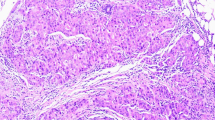Abstract
Because of the rarity of apocrine carcinoma and lack of standardized criteria for the diagnosis, the definitive conclusions of clinicopathologic features and the prognosis has not been determined. We retrospectively examined data on 2091 curatively treated Japanese patients with primary breast carcinoma. Among them, 33 (1.6%) who had been diagnosed of apocrine carcinoma were reviewed. Compared with non-apocrine carcinoma, apocrine carcinoma was characterized by less positive rates of ER and PR, and by frequent rates of unilateral multicentric breast carcinoma with significant difference. The clinicopathological factors influencing 12-year survival rate were lymph node metastasis, lymphatic involvement and vascular involvement. There was no difference in survival rates at 10 years after operation between apocrine carcinoma and non-apocrine carcinoma. Our result shows unique hormone response and unilateral multicentricity are only typical clinicopathological features of apocrine carcinoma.
Similar content being viewed by others
References
Abati AD, Kimmel M, Rosen PP: Apocrine mammary carcinoma. A clinicopathologic study of 72 cases. Am J Clin Pathol 94: 371–377, 1990
Moriya T, Sakamoto K, Sasano H <nt>et al.</nt>: Immunohistochemical analysis of Ki-67, p53, p21, and p27 in benign and malignant apocrine lesions of the breast: its correlation to histologic ndings in 43 cases. Mod Pathol 13: 13–18, 2000
Page DL, Vander Zwaag R, Rogers LW, Williams LT, Walker WE, Hartmann WH: Relation between component parts of brocystic disease complex and breast cancer. J Natl Cancer Inst 61: 1055–1063, 1978
Dixon JM, Lumsden AB, Miller WR: The relationship of cyst type to risk factors for breast cancer and the subsequent development of breast cancer in patients with breast cystic disease. Eur J Cancer Clin Oncol 21: 1047–1050, 1985
Durham JR, Fechner RE: The histologic spectrum of apocrine lesions of the breast: Am J Clin Pathol 113: 3–18, 2000
Tavassoli FA, Norris HJ. Intraductal apocrine carcinoma: a clinicopathologic study of 37 cases. Mod Pathol 7: 813–818, 1994
Leal C, Henrique R, Monteiro P <nt>et al.</nt>: Apocrine ductal carcinoma in situ of the breast: histologic classification and expression of biologic markers. Hum Pathol 32: 487–493, 2001
Tominaga S, Kuroishi T: Epidemiology of breast cancer in Japan. Breast Cancer 2: 1–7, 1995
Merchant WJ, Millis RR, Smith P, Chaudary MA, Barnes DM: Expression of c-erbB2 and p53 protein is similar in breast cancer from British and Japanese women. Int J Cancer 84: 278–283, 1999
Matsuo K, Fukutomi T, Tsuda H, Kanai Y, Tanaka SA, Nanasawa T: Apocrine carcinoma of the breast: clinicopathological analysis and histological subclassification of 12 cases. Breast Cancer 5: 279–284, 1998
Matsuo K, Fukutomi T, Hasegawa T, Akashi-Tanaka S, Nanasawa T, Tsuda H: Histological and immunohistochemical analysis of apocrine breast carcinoma. Breast cancer 9: 43–49, 2002
Fu L, Tsuchiya S, Matsuyama I, Ishii K: Clinicopathologic features and incidence of invasive lobular carcinoma in Japanese women. Pathol Int 48: 348–354, 1998
Gilles R, Lesnik A, Guinebretiere JM <nt>et al.</nt>: Apocrine carcionoma: clinical and mammographic features. Radiology 190: 495–497, 1994
Bratthauer GL, Lininger RA, Man YG, Tavassoli FA: Androgen and estrogen receptor mRNA status in apocrine carcinomas. Diagn Mol Pathol 11: 113–118, 2002
Gatalica Z: Immunohistochemical analysis of apocrine breast lesions. Consistent over-expression of androgen receptor accompanied by the loss of estrogen and progesterone receptors in apocrine metaplasia and apocrine carcinoma in situ. Pathol Res Pract 193: 753–758, 1997
Cauley JA, Lucas FL, Kuller LH, Stone K, Browner W, Cummings SR: Elevated serum estradiol and testosterone concentrations are associated with a high risk for breast cancer. Study of Osteoporotic Fractures Research Group. Ann Intern Med 130: 270–277, 1999
Gilchrist KW, Gould VE, Hirschl S <nt>et al.</nt>: Interobserver variation in the identi cation of breast carcinomas in intramammary lymphatics. Hum Pathol 13: 170–172, 1982
de Mascarel I, Bonichon F, Durand M <nt>et al.</nt>: Obvious peritumoral emboli: an elusive prognostic factor reappraised. Multivariate analysis of 1320 node-negative breast cancers. Eur J Cancer 34: 58–65, 1998
Lauria R, Perrone F, Carlomagno C <nt>et al.</nt>: The prognostic value of lymphatic and blood vessel invasion in operable breast cancer. Cancer 76: 1772–1778, 1995
Weigand RA, Isenberg WM, Russo J, Brennan MJ, Rich MA: Blood vessel invasion and axillary lymph node involvement as prognostic indicators for human breast cancer. Cancer 50: 962–969, 1982
Hasebe T, Sasaki S, Imoto S, Ochiai A: Histological characteristic of tumors in blood vessels play an important role in tumor progression of invasive ductal carcinoma of the breast. Cancer Sci 94: 158–165, 2003
Nagy JA, Brown LF, Senger DR <nt>et al.</nt>: Pathogenesis of tumor stroma generation: a critical role for leaky blood vessels and brin deposition. Biochim Biophys Acta 948: 305–326, 1989
McBoyle MF, Razek HA, Carter JL, Helmer SD: Tubular carcinoma of the breast: an institutional review. Am Surg 63: 639–644, 1997
Lesser ML, Rosen PP, Kinne DW: Multicentricity and bilaterality in invasive breast carcinoma. Surgery 91: 234–240, 1982
Author information
Authors and Affiliations
Rights and permissions
About this article
Cite this article
Takeuchi, H., Tsuji, K., Ueo, H. et al. Clinicopathological feature and long-term prognosis of apocrine carcinoma of the breast in Japanese women. Breast Cancer Res Treat 88, 49–54 (2004). https://doi.org/10.1007/s10549-004-9495-z
Issue Date:
DOI: https://doi.org/10.1007/s10549-004-9495-z




